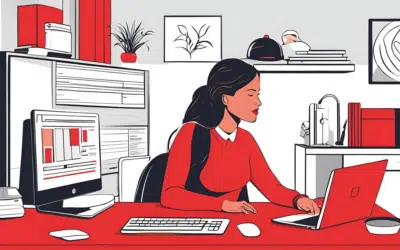
“Neck muscles, in their proper position, are designed to support the weight of your head, about 10 to 12 pounds,” says Dr. Robert Bolash, a pain specialist at Cleveland Clinic. “Research shows that for every inch you drop your head forward, you double the load on those muscles. Looking down at your smartphone, with your chin to your chest, can put about 60 pounds of force on your neck.”
Rather than feeling the aches and pains relating to technological use on a regular basis, learn what you can do to stay loose:
Get Up and Moving
Working on a computer all day generally means engaging in a whole lot of sitting. Sitting for long periods can result in a myriad of unpleasant health problems, including strained neck, back problems, “foggy brain,” muscle degeneration, organ damage, and even increased risk of colon, endometrial, and breast cancers.
If your job means adventures in sitting, remember to get up and stretch every 20 to 30 minutes. Walk around, touch your toes, use the restroom, roll your shoulders—there’s plenty you can do to pump fresh blood and oxygen through your body. The more you move around each day, the better…and don’t forget to exercise. Walk to and from work, go for bike rides, swim at your local community center, join a local volleyball league—whatever you want to do to stay flexible.
Sit Correctly
In addition to moving around whenever you can, it’s also important to sit correctly. This applies to smartphone, tablet, and laptop use. Sit upright so your back is against your seat and your abdominal muscles are engaged. Avoid slouching whenever possible.
Take Longer Breaks
Have hours of work to do on your laptop or other device? Give yourself the gift of longer breaks. As much as you might want to resist this idea to get work done, think of the pinched nerves, strained muscles, and disc herniations you’ll side-step. Walk around the room a few times, do a few yoga moves, have a five-minute dance party, sort the mail—as long as you’re up and moving, you’re good.
Hold Your Phone Out
Instead of holding your phone in your lap, save yourself from “text neck” by holding it straight out in front of you. Position the device so it’s in front of your face and your head is sitting squarely on your shoulders. This position may seem a little awkward at first, but it’s very helpful to your neck, and gives you a chance to work your arms a bit.
Use the 20-20-20 Rule
Just spent the last however long reading or working on your laptop or smartphone? Use the 20-20-20 rule. Look at something that’s 20 or more feet away every 20 minutes for at least 20 seconds. This significantly reduces Computer Vision Syndrome, which causes eyestrain, dry eyes, blurred vision, headaches, and neck and shoulder pain. Symptoms are exacerbated by poor posture and lighting, as well as vision problems.
Try a Body-Standing Desk
If you’re sick of sitting all day, try investing in a body-standing desk, or see if using such desks is possible within your company. These desks make staring straight at your computer screen possible, and save you from the health dangers of sitting all day. Many who use body-standing desks say they’ll never go back to “regular” desks.
Implement these changes and see if you feel a lot better in a short period of time!








